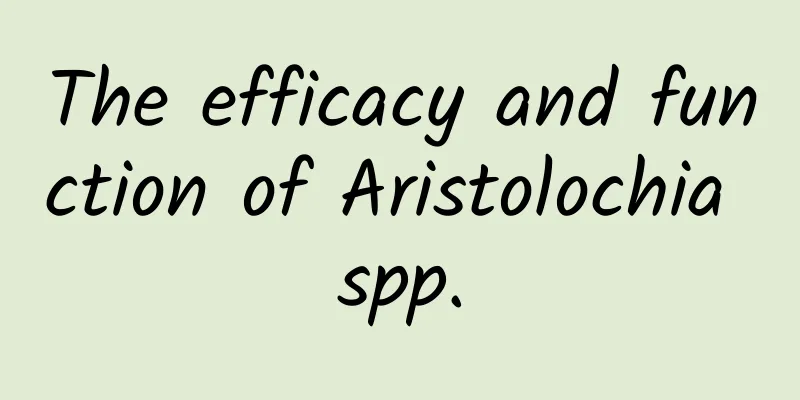The efficacy and function of Aristolochia spp.

|
Many people are very familiar with Aristolochia dasyphylla. The benefits that Aristolochia dasyphylla brings to us are not available in other foods. So what are the effects of Aristolochia scabra? Let’s learn about it together. [Alias] Platinum olive, mountain steward, and hundred-leaf potato. [Source] Medicinal material source: It is the root of Aristolochia hongkongensis of the Aristolochiaceae family. [Original morphology] Aristolochia hongkongensis is a woody vine; young branches are green, densely covered with short soft hairs; petioles are 1-1.5cm long and slightly hairy; leaf blades are leathery or papery, narrowly oblong-lanceolate or narrowly oblong, 12-20cm long, 2-5cm wide, with short pointed tips, narrowly auriculate base, and slightly covered with long soft hairs beneath; there are 3 basal veins, 8-12 lateral veins on each side, arching upward to the edge and connecting with each other, and the reticulate veins are obviously protruding underneath. The raceme is covered with brown silky long soft hairs; the pedicel is 7-12cm long, often drooping downward; the perianth tube is sharply bent in the middle, up to 5cm long at the bottom, 1.5-2cm in diameter, shorter and thicker from the bend to the eaves than the lower part, often attached to each other, yellow with purple longitudinal veins; the eaves are disc-shaped, inverted heart-shaped, 8-13cm in diameter, yellow-white with purple patches on the upper surface, the patches become more obvious towards the middle of the tube, with reticular veins, the margins are not obviously 3 shallowly cracked or only concave at the tip; the lobes are flat, the lobes below are slightly larger; the throat is dark purple, semicircular, about 1.5cm in diameter; the anthers are oblong, attached to the pygmy column in pairs near the base, and opposite to its lobes; the ovary is cylindrical, about 1.5cm long; the pygmy column is fleshy, with 3 deep cracks at the tip; the margins of the lobes extend downward, with nipple-like protrusions, and the flowering period is March-April. 【Habitat distribution】Ecological environment: Grown in valley forests. 【Nature and flavor】 Bitter; Cold 【Functions and indications】Dispel wind and promote diuresis; clear away heat and detoxify. It is mainly used for edema, gonorrhea, rheumatic pain, beriberi, enteritis, dysentery, mumps, mastitis, and allergic dermatitis. [Usage and Dosage] For oral use: decocted in water, 9-15g; or made into powder. For external use: grind appropriate amount into powder, mix with vinegar and apply. 【Excerpt】 Chinese Materia Medica This is all we have to say about the effects of Aristolochia spp., I hope it will be helpful to you. Although the value of Aristolochia scabra is very high, we must be cautious when eating it. |
<<: The efficacy and function of Baijieteng
>>: The efficacy and function of Yunnan five flavors
Recommend
The efficacy and function of soybean yellow roll
Soybean yellow roll has a long history, and until...
Tianzhou-2 has retired with honor. What contributions has it made?
Recently, the reporter learned from the China Man...
How long does it take to boil Chinese medicine?
When we are undergoing traditional Chinese medici...
Is lard residue healthy? Finally there is a reliable answer
Expert of this article: Zhang Zhaomin, Master of ...
Can mulberries be drunk with wolfberries?
Mulberries are a common fruit in daily life. Mulb...
Heart regeneration is no longer a dream? Please "patch" the failing heart
The heart is one of the most important organs in ...
The efficacy and function of the drupewood
The Chinese wolfberry is a medicinal material tha...
The efficacy and function of red compress
Hongfudifa is a common Chinese medicine. It can b...
The efficacy and function of goose fat
Wild goose fat is a very familiar medicinal mater...
Don't sleep, wake up! I'm hibernating
Have you noticed that after a large wave of rainf...
Are these “mysterious circles” in the desert really the work of aliens?
In the desert grasslands of Namibia in southern A...
Walnut wood
Walnut pith wood is actually a relatively common ...
Beware! "Meihua" strengthens to strong typhoon level, with maximum wind force 14! Bringing heavy rain!
Pay attention!!! Typhoon Meihua strengthens to se...
China's three generations of trains in one frame! See China's railway speed counterattack
Produced by: Science Popularization China Author:...









